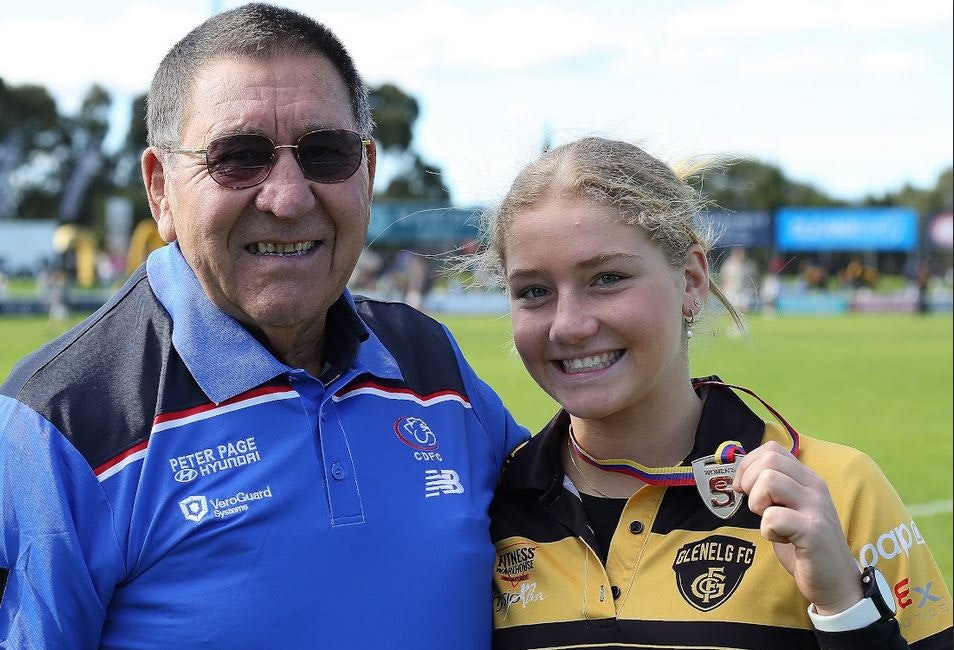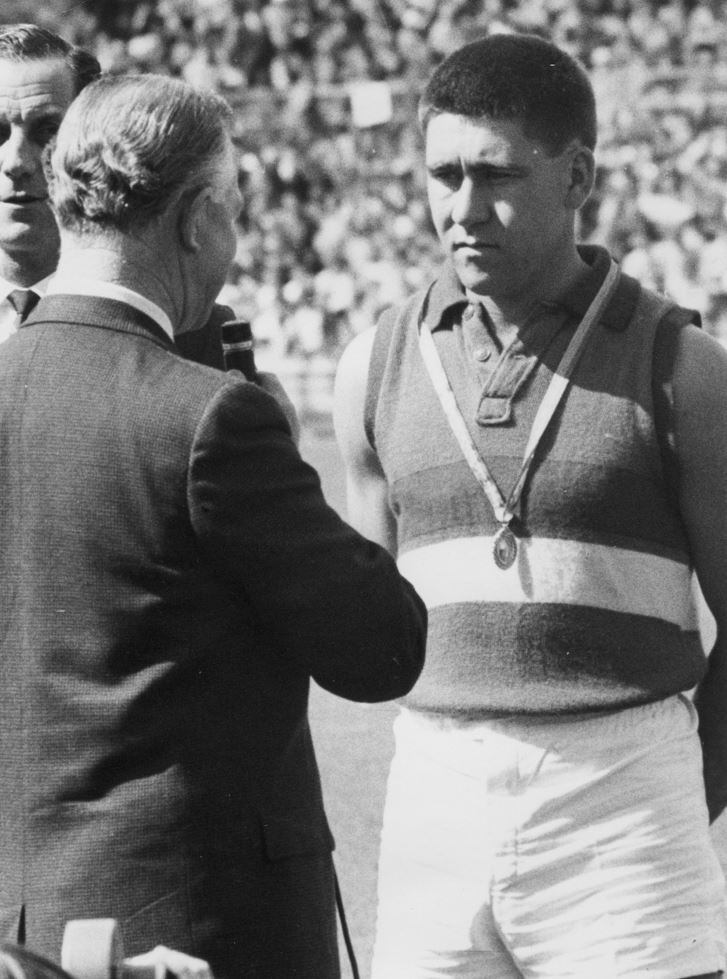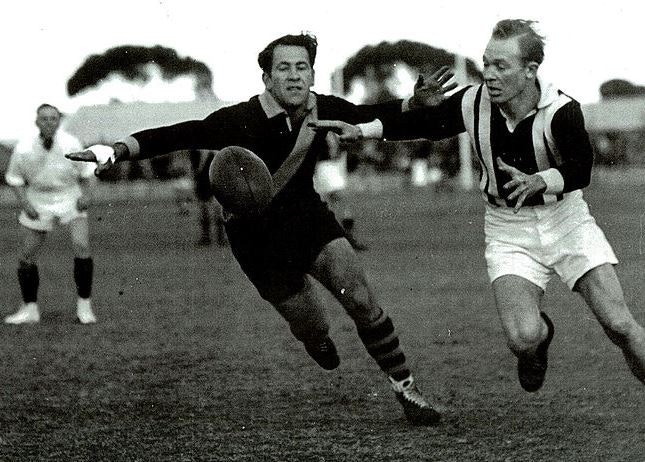
A Window into the next generation
By PETER CORNWALL
Piper Window reckoned her grandpa might have been lost for words.
For SA footy fans who know Gary Window, that seemed unlikely. But they had just achieved something even less likely, something never done before.
Piper has emulated the feat of her grandfather in winning a SANFL league fairest and most brilliant medal. The dynamic 17-year-old Glenelg midfielder won the Hostplus SANFLW best and fairest 58 years after Gary had snared the Magarey Medal.
There’s already plenty of history in the Window family, spanning four generations of SANFL league footballers. Gary’s father, Clarrie, was an outstanding Glenelg defender who represented SA.
Central District great Gary needs little introduction. He was captain in the club’s first league game, in 1964. He was its first Magarey winner and a Bulldogs best-and-fairest.
The SA Football Hall of Famer coached the Dogs and as a highly-popular, wonderfully passionate commentator continued to be known to generations of SANFL fans. Gary’s son Peter – Piper’s dad – played league footy with West Adelaide and Central. And Piper’s brother Hunter is a member of the Bays’ senior squad.
But it was Piper who was in the spotlight in the Magarey Room at Adelaide Oval as she made a stunning clean sweep of this year’s SANFLW awards. The quicksilver on-baller polled 19 votes to finish two ahead of West Adelaide’s Zoe Venning.
“This is incredible. I love playing footy. I love going to training with the girls – sometimes you have a bad day but when you go to training it makes it all better,” said Window, who was adjudged best-afield in five games.
Piper also won the Kia Coaches Award, polling 59 votes, Norwood’s Tahlita Buethke second on 44 and, not surprisingly, earned the Powerade Breakthrough Player award as most promising under-21 player.
And she was selected as ruck-rover in The Advertiser SANFLW Team of the Year. She spent more time out on the stage collecting awards than at her table having dinner.
Gary couldn’t have been more excited. “It was unbelievable. We’re all so proud of her,” he said.
Piper, who has played 33 SANFLW games and is destined to soon make her mark at the highest level, is already one-up on the rest of her remarkable family. She is a league premiership player. In just her 11th game and despite being just 15, she was one of Glenelg’s best players in its 23-point grand final win against West in 2021.

Central District’s Gary Window receiving his 1965 Magarey Medal.
While Bulldogs great Gary was cheering Piper’s Tigers on, barracking for Glenelg had been a weekly occurrence in the late 1940s up to 1950.
Clarrie Window played 72 games for the Tigers in a War-interrupted career between 1940-50. A rugged half-back, he would trek down from Gawler to play for the Bays and in the last few years of his career Gary would join him on the train trip to the city, followed by catching the tram to Glenelg.
Young Gary loved carrying his dad’s kit bag on game day, even though “the boots were heavy … they were great big clodhoppers”, and it was a long day by the time they had trekked from Gawler to the Bay and back.
“Stan Wickham was a conductor on the tram when we came down here,” Gary recalled and, as a youngster, he was immersed in Glenelg. “I loved it – I thought they were the bees’ knees.” His heroes were Ted Robjent, Allan Crabb, Colin Churchett and the Taylor brothers. And his dad, of course.
Clarrie had started making a name for himself as a footballer with Willaston – as an 18-year-old he starred with brothers Cyril and Dave in the club’s 1939 Gawler Football Association grand final win. There was no league team in the area in those days, two decades before Central District made its first appearance in the B grade, when Gary was its most promising youngster.
When Glenelg showed interest in Clarrie, he was undaunted by the thought of travelling down without a car. He was super fit and always willing to throw his bike onto a train at Gawler and when he reached the city, cycle wherever he needed to go. Clarrie played his first three league games for Glenelg late in the 1940 season but was posted to Brisbane with the Army in World War II and didn’t play for the Bays again until 1946.
“It would take a couple of hours (to get from Gawler to Glenelg for a game),” Gary said. “Dad wouldn’t worry about that. He was very dedicated.” Clarrie was such a strong mark he was dubbed ‘Sticky Fingers’ by his team-mates.
It’s a trait Piper has inherited. Clarrie’s good hands combined with his straight-ahead attack on the footy made him an outstanding player in the wet and it helped him shine in muddy conditions at the 1950 national championship in Brisbane. Window was at the peak of his powers when he played his last game for the Tigers. It also happened to be the biggest game he had played in, the 1950 grand final.
He formed a powerful half-back line with Don Taylor and Brian Wright but they could not stop Norwood snaring the flag. Clarrie, aged 30, then accepted an offer to captain-coach West Whyalla. Clarrie, with brother Les, Russell Stopp and Jimmy Banks, in 1954 established Salisbury North Football Club and, as an outstanding junior, Gary played here with his dad.
When Central District was formed, Gary was disappointed he had to play reserves footy for five seasons before he belatedly played at league level – he won the reserves Magarey Medal in 1963 before winning the league Medal in 1965 – as the Bulldogs served a long apprenticeship.
“I should have been playing league football in 1958-59 when I was about 18 but all of a sudden it was karma because I ended up getting all these firsts – first captain, first State player, first Magarey Medal,” he said.
Gary’s son Peter also played at Central, in five league games, while also playing five with Westies. And he spent some time at Glenelg as under-19s coach and league runner. When Piper started with Glenelg, Gary was delighted, and not because her debut was on Elizabeth Oval.
“It felt great – because of dad,” he said of her playing with the Tigers. “He would be so amazed by what she has done. She’s terrific, she’s done so well … I would never have dreamt of it.”
Piper is writing her own history. While adding to the Window legend.

Clarrie Window chases the ball down against Port Adelaide in 1950.
Related News
-
 Club News
Club NewsSANFLW Match Wrap | Round 13
-
 Team Selections
Team SelectionsSANFLW Round 13 Team Selections | Season 2025
-
 Club News
Club NewsSANFLW Match Wrap | Round 12
-
 Club News
Club NewsSam Franson to hang up her boots on an exceptional SANFLW career
-
 Team Selections
Team SelectionsSANFLW Round 12 Team Selections | Season 2025
-
 Club News
Club NewsJess Bates to finish SANFLW career in 2025
-
 Club News
Club NewsSANFLW Match Wrap | Round 11
-
 Team Selections
Team SelectionsSANFLW Round 11 Team Selections | Season 2025






























